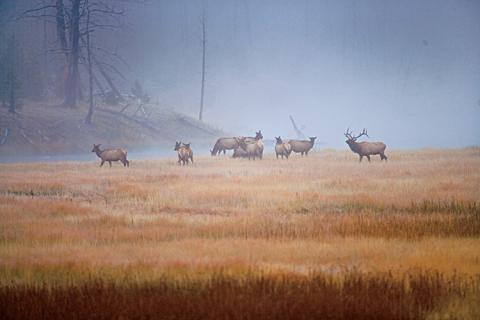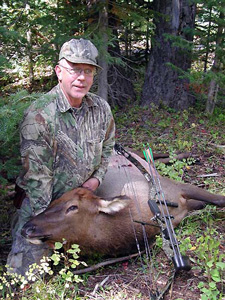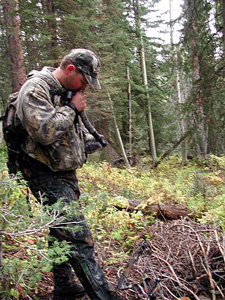
Wapiti. Monarch of the Mountains. Cervus Canadensis. Elk. Whatever name you choose, dreaming about an elk bowhunt sends chills and waves of adrenaline throughout a bowhunter's body. And that's just thinking about bowhunting for elk.
 |
| While preparing for your elk hunt, focus on two things: bowhunting skills and elk knowledge. |
Put yourself on a mountain, 10,000 feet above sea level, amid pines and rock and fallen timber. All is quiet, as you step gingerly past a recently used wallow and continue to follow the fresh elk tracks left in the mud. You whisper to your hunting buddy as you pick your way farther down the mountain, and then an earth-shattering bugle explodes from beneath you, 300 feet down. Both your heads snap upward and you stare wide-eyed at one another until the echoes from across the valley subside and your pounding heart floods your ears.
Months before you step onto that mountain, you need to prepare for the moment described above. Here are some helpful tips on how to do so.
Once you've decided to head out for your first elk bow hunt, the first thing you should do is to make lists — lots of lists. Organize what you need and what you already have for your hunt. Compile separate lists for clothing needs, camping/lodging needs and hunting gear needs.
Clothing Essentials
- Scent-containment base layers and camouflage;
- Non-cotton layering tops (base layers, crew necks and turtle necks) and bottoms (some great choices include: polypropylene, capilene and fleece);
- Two sets un-insulated camo;
- One set insulated camo;
- Two pairs waterproof boots, well worn and ready for heavy hiking and climbing;
- Hats; one waterproof, one stocking hat and one baseball hat;
- Several pairs of socks of differing weights
- Light long underwear, heavy/polartec long underwear
- Rain gear
- Two to three pairs of gloves; two lightweight, one insulated, and two pairs should be waterproof;
- Jeans
Camping?
If you plan to camp, your list will be extensive.
You'll need all the basics for shelter, along with insulated sleeping bags, pillows, cots, plastic tubs for storing clothes, food and gear, lanterns, LED flashlights, heaters, generators, gas, cook stove and propane, coolers and ice, water carriers and purifiers, cooking utensils, pots and pans, along with everything needed to process and store fresh elk meat, like rope, game bags, freezer paper and baggies. Don't forget to take plenty of garbage bags — you'll need to pack out everything you bring in.
If possible, consider taking a compact chest freezer that can be run by the generator and used to freeze and store meat. The generator can also be used to run a heater at night if needed. Bring extension cords and a power strip. Don't forget your scent-free wipes, soaps and shampoos, and of course a shovel and toilet paper.
Hunting Gear
Your bow should be perfectly tuned and secured in a good, strong bow case for travel. If driving, make sure to secure bows in a place where they won't shift during the long journey. You'll be entirely self-sufficient and must be duly prepared, especially if you're camping and not using the help of a guide or outfitter.
Hunting Essentials
- Hunting license, hunter's safety card and proper indentification
- Bow with sturdy, well-padded bow case for traveling by car or air
- Extra bowstring, Allen wrenches, extra nocks, peep, serving material and wax
- Broadheads, already assembled and on arrows, safely secured in quiver
- Bow press
- Extra pins for sight
- Target for practice at camp
- LED flashlights and plenty of extra batteries
- Waterproof headlamps with extra batteries and bulbs
- Pocket tissues and toilet paper
- Hand and feet warmers
- Waterproof matches, mirror, paper and pencil
- Compass and GPS — carry both at all times
- Personal Locator Beacon or Emergency position-indicating radio beacons (EPIRB)
- Laminated topo maps and highway and road maps of the local area
- Topo maps downloaded to your smartphone
- Cell phone and solar charger
- Compact digital camera, extra batteries, extra cards and solar charger
- Rangefinder
- Binoculars (waterproof) and lens cleaning cloths
- Spotting scope
- Elk calls, cow calls and bugle call
- Scent-controlled clothing and scent block spray
- Fanny pack with water holsters and/or hydration backpack with 2-liter reservoir
- Frame packs for packing out fresh elk meat
- Water and water purification tablets to keep with you in case of emergency
- Packaged and portable snacks and food for all day hunts
- Rope
- Duct tape
Preparing for the Bowhunt
Once you've made your lists, you'll know what you have and what you still need, but the next step is crucial. Preparing yourself and honing your skills for the actual hunt can mean the difference between coming home with an empty cooler or coming home with fresh elk to share with your friends.
 |
| Learn to imitate a cow call and a bull bugle. |
While preparing for your elk hunt, you'll need to focus on two things: bowhunting skills and elk knowledge. Figure out what you know about elk and what you need to learn. Have you hunted elk before? Can you imitate a cow call? A bugle? Do you know where the kill zone on an elk is? Do you know how they move on a mountain? Do you know how to field dress an elk and prepare the meat for freezing?
For your first elk hunt, you must flood your mind with everything elk. Watch television shows and videos about elk hunting. Read articles. Search the Internet for information about their feeding habits, mating habits and territorial behaviors. Learn about elk sign and habitat. Study their anatomy. Most importantly — get to the target range and practice shooting your bow every week or every day, if possible.
If necessary, work on increasing your draw weight for better penetration and kinetic energy for shots taken in the field at longer distances. Know your shooting abilities with your bow and stay within your pre-determined limits for effective kill shots. Be sure your 20, 30, 40 and even 50 pin is right on.
Be sure to shoot well from different positions: standing, squatting, kneeling and sitting on a log. Shoot in the open and shoot in the darkened woods amid brush. Practice judging distance in both places and check yourself with your rangefinder. Focus on your skills and your confidence using your bow.
Since many of us are not used to the large size of an elk in the wild, it's best to practice shooting at the largest 3D target you can get your hands on. The tremendous size of elk can be startling and throw-off your range estimation when they appear, so always verify yardages with a rangefinder before shooting. Be sure to check the regulations and hunting laws for harvest information and for determining what a legal bull in your hunting zone is before you arrive at your destination.
Conditioning for the Hunt
Prepare yourself for hiking and hunting at high altitudes by starting months in advance. The air is thinner; your heart will pump faster; and your legs will ache as you climb up and down mountainsides, so the earlier you begin your training, the better off you'll be.
Start walking and/or running with lightweight trail shoes on, increasing the intensity and duration of your workout as your ability and endurance increases. It's very hard to train for elevation, so the best solution may be to add weight training to your workout routine and add weight to your walking or running routine to be sure your body and lungs are conditioned. Begin by wearing your backpack during your workouts and gradually add weight to your pack. Start wearing your hiking boots both for the added weight but also to be sure they're well worn for full days of hiking on a mountain.
It's essential when hunting at elevation to remain hydrated. Drink lots of water throughout the day, increasing fluids in warmer weather.
If you have a headache, take note this may be a sign of elevation sickness. Headaches are common for many the first day or two at elevation as their bodies acclimate to the thin air at elevation. Treat it, but pay attention to your health and to others in your hunting party. Learn more about elevation sickness and its signs, and watch for them in yourself and others. If elevation sickness strikes someone, it's best to move them to lower elevations as quickly as possible and seek medical care.
Planning, organizing and training months before your departure date will help you avoid mistakes while also increasing your chances for success once you embark on your long-awaited elk adventure. Get in shape, educate yourself about elk, sharpen your shooting skills and carefully pack for your first bowhunt — then you'll be ready for a trip of a lifetime!
- 19302 views

